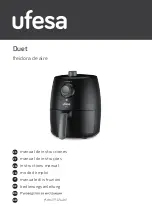
- 15 -
A 1/4 ounce package of RED STAR® yeast contains approximately 2 1/4 level teaspoons of yeast.When
the yeast is exposed to oxygen, moisture or wa rmth, the activity of it deteri o ra t e s. T h e r e fo r e, we
r e c o m m e n d storing yeast in an airtight container and refrigerating or freezing it. Measure out the amount
you need and allow it to come to room temperature before using it — this takes about 15 minutes.
If you have any doubt regarding the activity of the yeast, you may use one of the fo l l owing tests to
d e t e rm i n e its strength. Each test calls for a different amount of yeast as a base ingredient. This gives you
more bread choices once the test is complete.
To test for one package (2 1/4 teaspoons) of RED STAR® Active Dry or QUICK RISE Yeast, use a liquid
m e a s u ring cup and fill to the 1/2 cup level with 110°F/27°C-115°F/46°C wa t e r. Stir in 1 teaspoon
gra nulated sugar and 1 package (2 1/4 teaspoons) RED STAR® Active Dry or QUICK RISE Yeast.
Leave your stirring spoon in the cup. Set a timer for 10 minutes. As the yeast absorbs liquid, it will begin
to activate and rise to the surface. If at the end of the 10 minutes the yeast has multiplied to the 1 cup
mark, it is very active. The yeast mixture may be used in your Toastmaster® Breadmaker in a recipe that
calls for 2 1/4 teaspoons of ye a s t . Remember to adjust your recipe for the 1/2 cup of water and 2 1/4
t e a s p o o n s of yeast used in the test.The sugar does not need to be adjusted.
To test for 1 1/2 teaspoons of RED STAR® Active Dry or QUICK RISE Yeast, use a liquid measuring cup
and fill to the 1/4 cup level with 110°F/27°C-115°F/46°C water. Stir in 1 teaspoon granulated sugar and 1
1/2 teaspoons RED STAR® Active Dry or QUICK RISE Yeast. Leave your stirring spoon in the cup. Set a
timer for 10 minutes. As the yeast absorbs liquid, it will begin to activate and rise to the surface. If at the
end of the 10 minutes the yeast has multiplied to the 1/2 cup mark, it is very active. The yeast mixture
may be used in your Toastmaster® Breadmaker in a recipe that calls for 1 1/2 teaspoons or more of
yeast. Remember to adjust your recipe for the 1/4 cup of water and 1 1/2 teaspoons of yeast used in the
test.The sugar does not need to be adjusted.
n
Flour: Bread Flour is Essential for Yeast Breads
■
and Doughs
All types of flour are affected by many factors, such as milling grades, moisture content, length of storage
and manu fa c t u ring processes. Adjustments to the recipes may need to be made to compensate fo r
c l i m a t i c changes in different regions to ensure an excellent loaf.
Bread flour is a definite necessity. Milled from hard winter or spring wheat, it has a higher protein content
that makes it more durable than all-purpose flour. The protein, when mixed with liquid, becomes gluten.
When kneaded, gluten becomes elastic and gives the bread better structure. In contrast, all-purpose
f l o u r, milled from a combination of soft and hard wheat, becomes elastic too easily for use in a
b r e a d m a ke r and quickly loses its ability to stretch well. As a result, bread made from all-purpose flour
will be small and dense. Several well-known mills now market bread flour. It is labeled bread flour on the
package and is available at grocery stores.
Wheat is the only grain that contains the type of protein that becomes elastic when kneaded. Other
flours, such as r ye, barley, oats, soy, rice and buckwheat, add flavor and fiber to breads but do not add
structure to the dough.Therefore, wheat flour is essential as a base when making bread.
Vital Wheat Gluten is produced by processing white flour one more step. White flour contains both
p r o t e i n and starch, and mills now can remove most of the starch leaving only the protein (gluten).When
gluten is added to recipes containing whole grain flours, it improves the volume and shape of the loaf
s i g n i f i c a n t l y. Many grocery stores stock gluten in the flour section. Health food and nutrition centers also
carry this item.
Flour is best kept in an airtight container. If you are storing the flour for a long period of time, you may
want to keep it in the freezer as the refrigerator tends to dry it out.Whole grain wheat flours, which have
a higher oil content, will become rancid much more quickly than white flour and should always be kept in
the freezer. Be sure, however, to allow all flours to return to room temperature before placing in the
machine.
Summary of Contents for Breadmaker's Hearth 1143S
Page 12: ...12 BREADMAKER FUNCTION...
Page 13: ...13 n Breadmaker Program Specifications...
















































